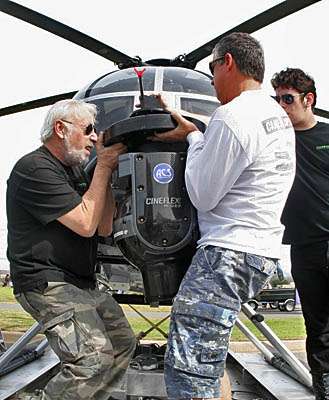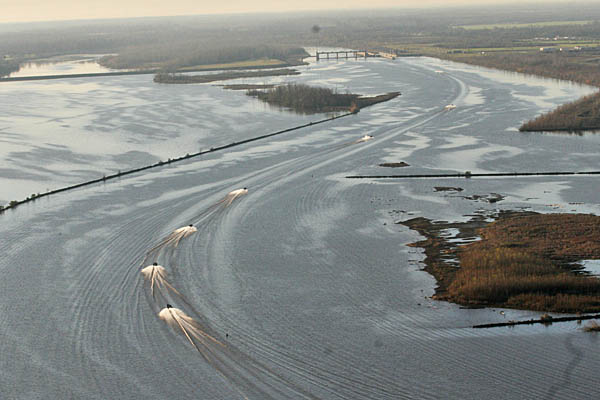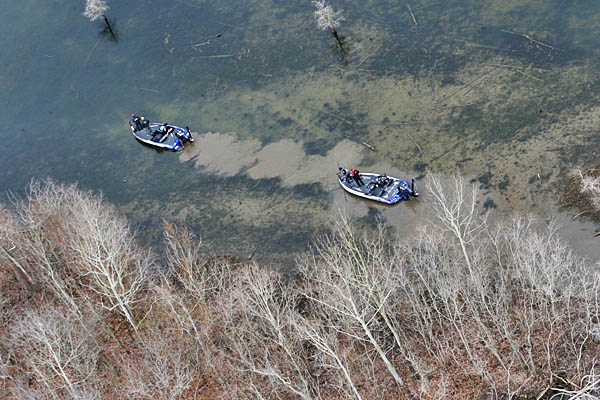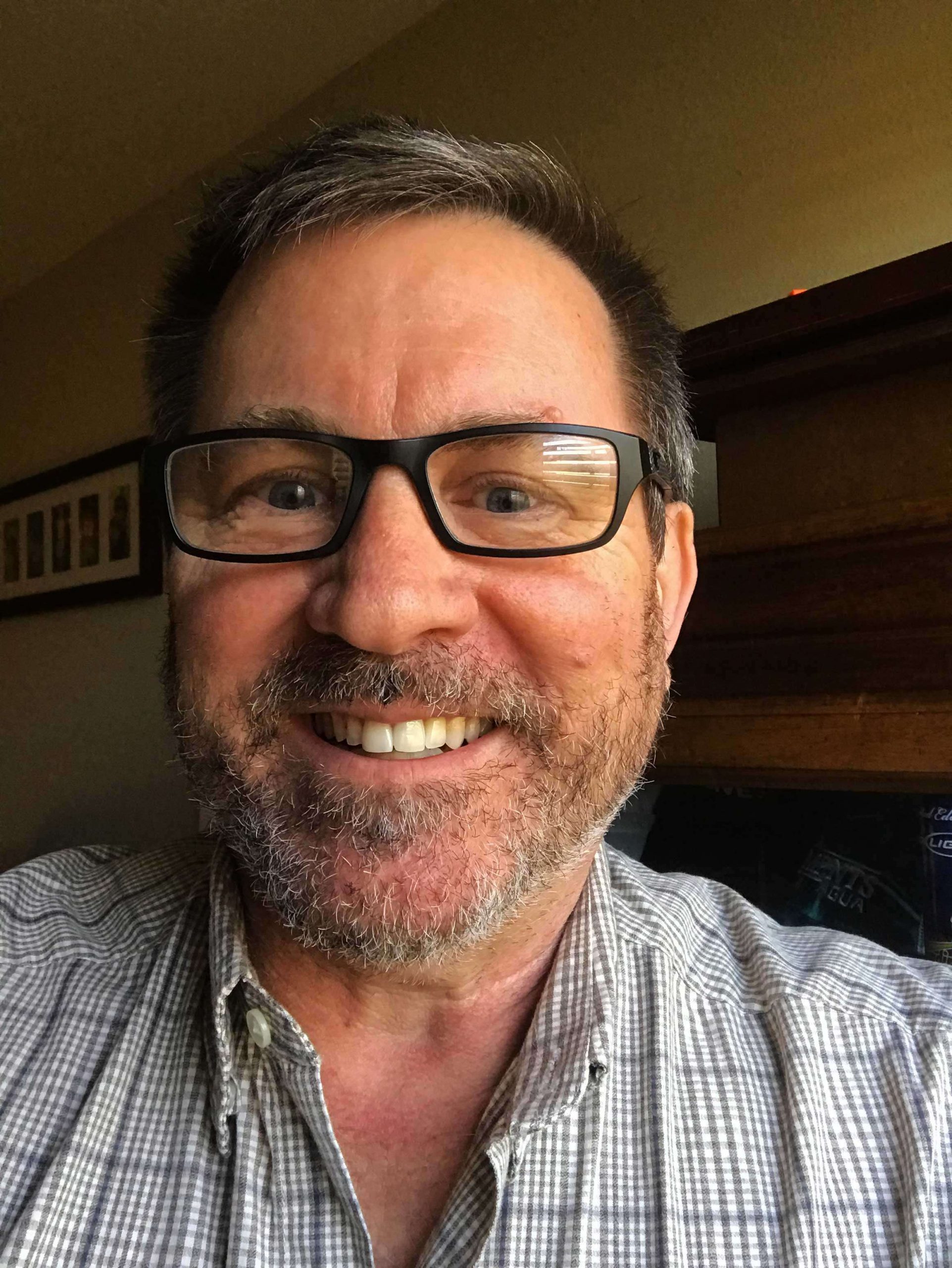
SHREVEPORT-BOSSIER CITY, La. – Part James Bond, part Most Interesting Man in the World, Paul Barth and Steve Cassidy fly and shoot for a living, and they get clearance from the U.S. Department of Defense to do it.
Ten years ago, Barth and Cassidy teamed up to form Camera Copters, which provides aerial footage for Bassmaster TV shows, among others. A transport truck that houses a Hughes/MD-500 helicopter is right out of 007 lore, and their camera is equipped with gyro-stabilizers that are the basis of cruise missile technology.
Have copter camera, will travel, and they do for 200 to 300 days a year.
“The beauty of this truck and this whole setup is we can go on location anywhere in the U.S. — 48 states — and show up without an airport,” Barth said. “We have our gear, we have jet fuel, bring the helicopter out, put the camera system on, do our filming, put it back inside, next location.”
Sounds simple, but their individual expertise and choice of equipment provide exhilarating footage. Both are Screen Actors Guild members and have incredible resumes, from stunt flying for major motion pictures to filming CBS’s The Amazing Race and Paul McCartney’s Back in the U.S. Tour.
Barth, who began flying and working on helicopters at 18, had owned a fleet of 14 choppers but scaled down to three, his preference for video missions being the Hughes 500 “just because of what it can do in the air. It’s a smaller helicopter, plus it’s turbine, five blades. This helicopter is the most maneuverable and smoothest machine out there.”
Weighing less than a small car, the copter fits into a truck trailer and rolls down the custom designed door/ramp to the ground on a dolly. Like “working with a big erector set,” the crew puts on the blades, etc, and the camera equipment and wiring. The fastest they’ve gotten it ready to fly is a half hour.

The helicopter follows boats as they head for the lock to Pool 4. (Mike Suchan photo)
The 53-foot trailer pulled by a Kenworth T-2000 is a self-contained mobile base. It houses a full machine shop, kitchen, bathroom, shower along with a lounge for client viewing. It has its own power and fuel for the chopper. Barth said there are only two rigs like it in the world – he had both built and sold the first.
Flying for more than 30 years, Barth, who lives in Miami, has 17,000 hours in helicopters. That experience allows him to put Cassidy in position to get remarkable shots.
“Paul will put this thing down about 6 or 7 feet above the water,” Cassidy said, “going backwards at about 60-70 mph to be able get the good shots.”
The shots would be virtually useless without Cassidy’s CINEFLEX HD gyro-stabilized Cinealta camera system, which costs as much as the helicopter.
“It’s a pretty sophisticated piece of gear. There’s electronic gyro-stabilization that takes all the jitter and the shake out,” said Cassidy, who lives in Detroit and has done voiceovers for major networks as well as most of the auto makers there. “This gyro-stabilized camera runs around a half a million, if you want to go buy one.
“A couple of the solid state gyros that they use in this camera are what they call tactical-grade gyros. They’re sensitive enough to be used as the basis for cruise missile navigation systems. The State Department regulates this. We can’t just take it out of the country without permission. They want to know where it’s going to go and who has access to it. We have to have somebody with it at all times.”
As Barth navigates the copter, following anglers and chasing down requests of JM producers, Cassidy has his face in a hood looking at his screen while manipulating a control board with a joystick and all sorts of knobs and controls. He was asked where he learned to work the complicated device.
“At gyro-stabilize camera school,” he quipped.
Is there such a thing?
“Sure, somewhere. I haven’t been to that school but I hear that one exists,” he said. “I just bought one of these and learned how to use it.”
JM Associates, the TV production company of B.A.S.S., has used Camera Copters for almost a decade, including last weekend at the 2012 Bassmaster Classic. Producer Tim Schick said the aerial shots, which make up around 10 percent of the show, add to the appeal.
“Any time you can show the audience a different perspective, especially an aerial perspective, it helps tell the story of not only the competitors, but the playing field,” he said. “You can explain there are 150 miles of river, but until you see the aerial shots, you don’t get an idea of how expansive an area these guys can fish.
“At a place like this, we know the story line is clean water, dirty water, and it’s hard to show from a terrestrial point of view.”
The camera copter was a staple at the launches, and Barth said he can see the anglers get pumped when he pulls up to them running at full speed. The aerial view was critical in telling the Red River story, showing the disparity in water clarity and the difficulties of getting into shallow, out-of-the-way spots.
“It’s very hard to follow the action unless you’re in a helicopter,” Cassidy said. “Even if you’re in a boat, you’ve got to follow one guy and another goes off in another direction, you’re never going to find him again, so a helicopter is really essential.”
Barth called it B.A.S.S.’s eye in the sky, but one top 10 angler in the Classic is probably referring to the copter as a spy in the sky. Mark Zona, one of the show hosts, said the angler called him asking that helicopter footage of him wasn’t shown on this weekend’s Classic shows.
“He thought he had a place no one else knew about and doesn’t want it revealed,” Zona said.
Barth and Cassidy start each morning with a flight plan, something that has to be cleared with local authorities so they aren’t considered a bogey when they all of a sudden pop up on radar. On Day One, Barth was on the phone with Barksdale Air Force base setting up the altitude and position he needed to be to capture the B-52 flyover at the launch.
Although they follow a game plan, there are always audibles, like last year’s weather at the New Orleans Classic.
“Weather is a big issue,” Barth said. “Last year we got fogged in. It rolled in on top of the marina and we couldn’t fly. Fortunately, we were really close by and we were able to lift off and just stay right there by the marina for the launch. We couldn’t follow the boats because they were going off into zero visibility.”

Josh Polfer and Ish Monroe were caught on film getting stuck then poling their way into a shallow backwater. (Mike Suchan photo)
Once the event begins and the boats have scattered, communication is key. There is GPS on each competitor’s boat, and producers relay that information.
“This is a long river and vast areas,” Barth said. “We basically map out where these guys are most likely going to go. Obviously, no one knows for certain, so we have to kind of play it by ear. They’ll know about where they’re at, but even for us in the air it can be hard to find them.
“With this camera and Steve behind the controls, and I’m behind the controls of the helicopter, there’s nobody who can escape us. The more we do it together as a team, the smoother and better we have gotten, and we’ve been flying together for 10 years, 3,000 hours together, doing camera work all over the country.”
For more on Barth and Cassidy, go to their web site, www.cameracopters.com
See their work on the Bassmaster Classic TV shows on ESPN2. The hour-long Day One show airs at 10 a.m. ET Saturday, then is repeated Sunday at 6 a.m. followed by the Day Two show from 7-9 a.m. Day Three runs from 9:30 p.m. to 11:30. For complete list of air times, click here.

